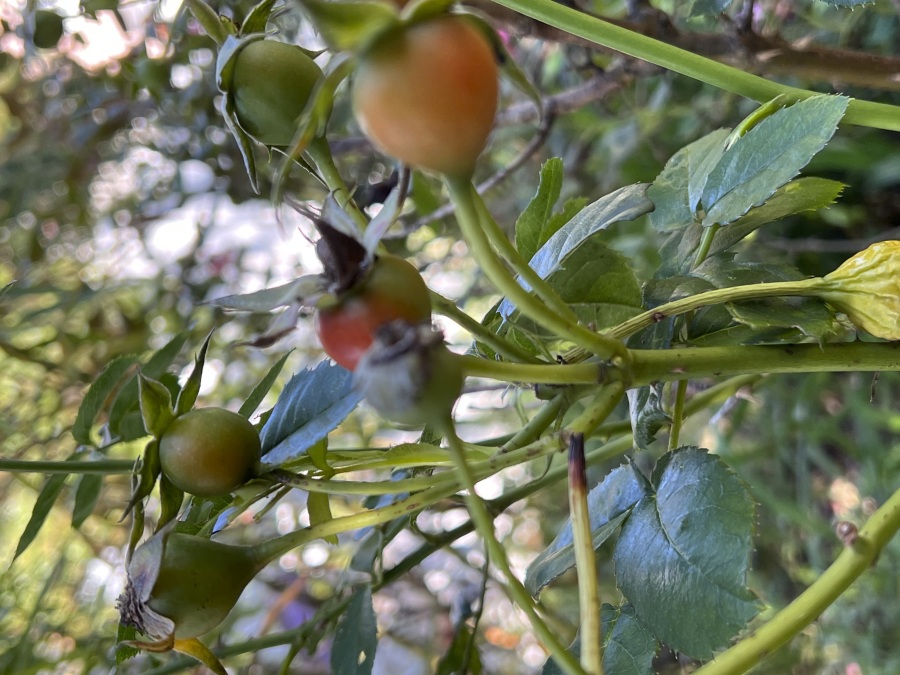The rose has long been regarded as the “queen of flowers,” revered for its fragrance and beauty. But less lauded are the orange and red hips, or seedpods, that form after the flowers fade. And that’s a shame.
If they’re left on the plant, the rose hips will take center stage in autumn and provide a beautiful pop of color through the winter — or at least until the birds get them.
Like every fruiting plant and tree, a rose’s blossoms will give way to fruit if left undisturbed. That fruit, the hip, contains a seed.
Not all roses produce hips, however. Some modern cultivars are sterile. For the biggest, best or tastiest hips, seek out rambling, shrub and wild, non-hybrid species roses. My favorites are the North American native Rosa Virginiana’s glossy, scarlet hips, Rosa glauca’s clusters of small, deep red hips, and Rosa rugosa’s sweet hips, which are so large and round they remind me of cherry tomatoes.
To improve and increase the hips your roses produce, treat plants to monthly applications of a bloom-boosting fertilizer during the growing season. The more roses the plant produces, the more hips you’ll have.
Stop deadheading roses in August to allow the last flush of blooms to develop hips.
Tea And Jam
Rich in vitamin C and high in antioxidants, calcium and magnesium, all rose hips are edible. However, most are too tart to eat without sweeteners, so they are used to make jams and jellies, syrups and tea-like beverages.
Only hips from plants not treated with pesticides should be considered for consumption.
To harvest, wait until after the first light frost, which will sweeten their flavor, then pull hips off the plant or clip them using scissors or pruners. Leave behind any that are dried up, shriveled or rotted.
To prepare hips for tea, remove petal remnants and other plant debris, then rinse well in cold water. Small hips can be dried whole, but if using large hips, like those of Rosa rugosa, slice them in half and remove the seed and prickly, hairy fibers from within before proceeding (fun fact: Those prickly rose seed fibers are used as a frequent ingredient in itching powder, the novelty item some might call the “king” of pranks).
Place cleaned hips in a food dehydrator or in a single layer on a baking sheet in a 100-degree oven for several hours until brittle, then store in an air-tight glass jar in a cool, dark place.
Then, whenever you’d like a steaming, nutritious beverage, add a heaping teaspoon of dried hips to a cup of boiling water and steep for 5-10 minutes. Sweeten to taste.
To make jams and jellies, clean and remove seeds as above, regardless of hip size, then simmer for 15 minutes. Strain out the solids, and use the resulting liquid in your favorite recipe.
If eating or drinking rose hips isn’t your, um, cup of tea, you might use them in seasonal decorations. Clip each hip (or cluster of hips) from plants with several inches of stem attached, then tuck them into autumn and winter wreaths or add to vases with or without cut flowers.
Making New Roses
Planting roses from seed doesn’t always yield reliable results, but if you’d like to try, slice open the hips, remove seeds and thoroughly rinse off any remaining pulp because it may prevent germination.
Fold seeds into a moist paper towel and seal in a zipper-top plastic bag, then refrigerate for 6-10 weeks (check the paper towel periodically and moisten lightly when it dries out).
After the chilling period, sow seeds indoors, ¼-deep in shallow containers or seedling trays filled with sterile seed-starting mix. Keep the soil consistently lightly moist but not soggy.
It can take one to four months for seeds to sprout, and germination rates are low. Increase your chances of success by tripling the number of seeds you sow.
Transplant seedlings outdoors in spring, after the danger of frost has passed – and hope for the best.



